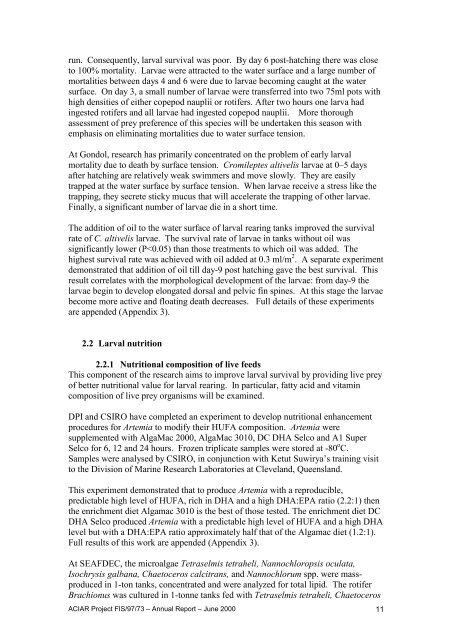ACIAR Project FIS/97/73 - Library - Network of Aquaculture Centres ...
ACIAR Project FIS/97/73 - Library - Network of Aquaculture Centres ...
ACIAR Project FIS/97/73 - Library - Network of Aquaculture Centres ...
You also want an ePaper? Increase the reach of your titles
YUMPU automatically turns print PDFs into web optimized ePapers that Google loves.
un. Consequently, larval survival was poor. By day 6 post-hatching there was closeto 100% mortality. Larvae were attracted to the water surface and a large number <strong>of</strong>mortalities between days 4 and 6 were due to larvae becoming caught at the watersurface. On day 3, a small number <strong>of</strong> larvae were transferred into two 75ml pots withhigh densities <strong>of</strong> either copepod nauplii or rotifers. After two hours one larva hadingested rotifers and all larvae had ingested copepod nauplii. More thoroughassessment <strong>of</strong> prey preference <strong>of</strong> this species will be undertaken this season withemphasis on eliminating mortalities due to water surface tension.At Gondol, research has primarily concentrated on the problem <strong>of</strong> early larvalmortality due to death by surface tension. Cromileptes altivelis larvae at 0–5 daysafter hatching are relatively weak swimmers and move slowly. They are easilytrapped at the water surface by surface tension. When larvae receive a stress like thetrapping, they secrete sticky mucus that will accelerate the trapping <strong>of</strong> other larvae.Finally, a significant number <strong>of</strong> larvae die in a short time.The addition <strong>of</strong> oil to the water surface <strong>of</strong> larval rearing tanks improved the survivalrate <strong>of</strong> C. altivelis larvae. The survival rate <strong>of</strong> larvae in tanks without oil wassignificantly lower (P
















